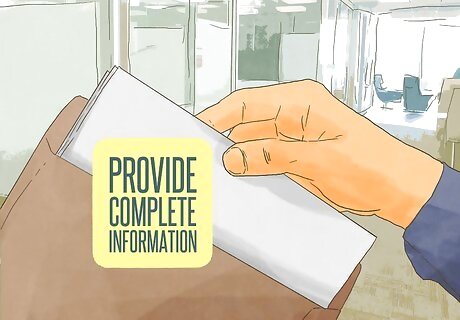
views
Using a Quitclaim Deed

Obtain the form deed from the recorder or register of deeds in the county where your house is located. With a quitclaim deed, you literally quit whatever claim you have to the property -- hence the name -- and transfer it to someone else. Quitclaim deeds are the most common way to transfer property among family members when money doesn’t change hands, or gift property to someone. With a quitclaim deed, there is no risk that you might be sued by your family member or a future buyer if it turns out there’s something wrong with the deed and you didn’t have full ownership of the house, because a quitclaim deed only transfers whatever claim of ownership you have. It doesn’t guarantee that you have any particular claim.

Fill out the form. A quitclaim deed has blanks for your name and the name of the family member to whom you’re transferring your home. You also have to enter the legal description of your home. You can use the description contained in your original deed if you have access to that, or use government plats or the street address. Since it’s a quitclaim deed, the description doesn’t have to be as specific as it would be otherwise. It just has to relate back to your original deed. The form also will have blanks for signatures, but you shouldn’t sign the form until you are in the presence of a notary.

Sign the deed in the presence of a notary. In some states, the family member to whom you’re transferring your house deed must also sign. Some states also require additional witnesses beyond just a notary.

Deliver the deed by hand or certified mail. Once you sign the deed making the transfer, it needs to go to the person who now owns the property. If the family member to whom you transferred your house wasn’t with you when you signed the deed, you can take it to them or mail it. Using certified mail or similar service ensures you know when they’ve received it.

Have your relative record the deed. After you’ve made the transfer, it’s the responsibility of the person to whom you transferred your house to record the deed at the county recorder’s office. Otherwise it won’t become part of the legal record of the property and could cause problems later on.
Using a TOD Deed

Find out if a transfer-on-death deed is available where you live. The TOD deed enables you to maintain full control of your property while you’re alive, but transfer it to your relative of choice when you die without going through probate. As of 2015, 22 states and the District of Columbia offer TOD deeds, including Colorado, Illinois, Ohio and Virginia. Check with your county recorder’s office to learn if this option is available to you. If your reason for transferring your house to a family member is to avoid probate, a TOD deed may be a better solution for you because it allows you to maintain control of your house while you’re alive.

Draw up the deed. A TOD deed looks like any other deed, but includes a statement that it doesn’t take effect until the owner’s death. Each state has particular requirements, so you might consider consulting a real estate attorney if you’re not confident in your ability to work through those requirements on your own.

Sign in front of a notary. Check your state’s law to ensure you don’t need other witnesses. The family member to whom you’re transferring your property does not need to be present.

Record your deed. After you’ve signed it, you must record it yourself at your county recorder’s office. Otherwise, no one will know it exists and it may never take effect. You may change your mind at any time and make another deed. You retain all title and ownership in your property until you die. Any mortgages or other liens on your property transfer automatically with a TOD deed. Like a quitclaim deed, you’re merely bequeathing your ownership interest in the property, whatever that may be. When you die, your chosen family member may need to present an affidavit and death certificate to take control of the property, but it’s still a quicker and easier process than going through probate.
Using a Warranty Deed

Contact a real estate attorney. Because warranty deeds are the most complicated method of transferring the title to your property, you most likely will want an attorney to guide you through the process. Warranty deeds, sometimes called grant deeds, come with a guarantee to the new property owner that you have good title to the property and no one else has any stake in it or claim to it. Because they are so complicated, warranty deeds typically aren’t used to transfer a house to a family member when no money is exchanged. Although complicated for you, a warranty deed gives the relative to whom you’re transferring your property more confidence, because you promise that you own the property free and clear of any mortgages or other encumbrances, and that no one else has a competing claim for the property. Navigate complex property laws. "I was totally lost trying to figure out how to legally put my house in my daughter's name. There are different rules everywhere, and I didn't know where to start. This article broke it down into simple steps for me. Now I get all my options, from quitclaim to warranty deeds. It's still complicated, but at least I understand what I need to do now and who to call if I need more help." - Victoria X. Understand risks before signing away rights. "When my uncle asked me to sign a quitclaim for his cabin, I really didn't get what that meant. Tips here opened my eyes about losing any ownership rights once I sign. It led me to look closer at state laws to grasp the pros and cons first instead of just doing it blindly. Now, I can make an informed call that protects my own interests." - Paul R. Discover hassle-free transfer options. "As a mom preparing to pass on my home, I dreaded my son facing legal headaches from probate someday. I felt so relieved reading about TOD deeds to automatically give him the place when I pass. Taking steps here to record it gives me peace of mind that the courts won't tie things up for him later." - Ella T. Enable joint ownership for a smoother transition. "I wanted to share ownership with my brother when mom passed, not getting the tax and healthcare access impacts. Walkthroughs spelled out how joint tenancy can play out in reality. It let my brother and I weigh caution before adjusting our approach. It really helped us pick the co-ownership setup that worked best for both." - Robert C. Did you know that wikiHow has collected over 365,000 reader stories since it started in 2005? We’d love to hear from you! Share your story here.

Conduct a title search on your property. Before you complete a warranty deed, a title search reviews the legal history of the property ensure the statements in the deed are correct and the title to the property is clean. This process can be expensive and time consuming. Although you can conduct a title search yourself, since property records are open to the public, a professional title searcher will do a more thorough job in less time than it would take you to do it yourself. Title insurance provides better protection against any defects in your title, either disclosed or hidden, that could cloud your deed with problems or even negate your transfer. Title insurance is expensive, and typically the cost is split between the original owner and the future owner.

Complete the deed. As with other types of deeds, your deed will provide details about you and the family member to whom you’re transferring your title, as well as a complete and detailed legal description of the property.

Sign the deed in front of a notary public and any other witnesses required by your state’s law.

Give the deed to the relative you want to receive the property.

Make sure the deed is recorded. This is technically your family member’s responsibility, but if you’ve hired an attorney to draw up the deed, she may offer to record the deed herself. The deed is still valid if it isn’t recorded, but failure to record it can cause significant problems later on because no one else will be aware of your relative’s claim to your property. Not recording the deed would eliminate all the gains you made by transferring your deed, including your attempt to avoid probate.
Creating a Joint Tenancy

Have a new deed prepared listing you and your relative as joint tenants with right of survivorship. To have a joint tenancy, you both must acquire equal shares at the same time. Preparing a new deed has the effect of you selling your property to you and your relative. Joint tenancy with right of survivorship means that when one of you dies, the other takes all interest in the property by operation of law. Keep in mind that since you are giving someone an interest in your property, you will owe gift taxes if that share of your property is worth more than $10,000.

Complete the deed. Since the only thing you are changing are the names on the deed, you can simply copy everything else on your older deed.

Sign the deed. Depending on your state's law, you may need to sign the deed in front of a notary public or other witnesses. Since you and your relative both are taking ownership of the property in this situation, you both must sign the deed.

Have the deed recorded. If you want to avoid probate, the deed must be recorded or the joint tenancy won't be a matter of public record.


















Comments
0 comment